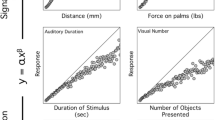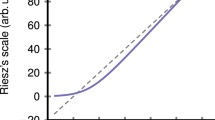Summary
The search for general laws governing our perceptual representation of the external world goes back at least to Fechner and is no less important now than it was then. Fechner used human discrimination performance to infer that the basic relationship between subjective intensity and the intensity of a physical stimulus was logarithmic. A hundred years later, Stevens demonstrated that direct subjective report frequently results in a power law rather than a logarithmic law. However, it was soon appreciated that power laws and logarithmic laws are indistinguishable without peering inside the mechanisms leading to a subject’s responses. After doing so, Mountcastle and his colleagues proposed that the basic law is linearity between the neural representation of an intensive continuum and its subjective magnitude. We were drawn to the same conclusion in a study of the neural coding mechanisms of roughness perception that was designed to be independent of any assumptions about the basic laws of psychophysics. We adopted consistency as the test of neural coding hypotheses. The single, consistent neural coding hypothesis that survived all challenges resulted in a linear relationship between the neural coding measure and subjects’ reports of intensity. That hypothesis was that roughness perception depends on spatial variation in the SAI afferent population response. This study and other similar studies support the idea that once the internal neural representation of intensity is established, the fundamental laws are linear, as Mountcastle proposed over thirty years ago.
Access this chapter
Tax calculation will be finalised at checkout
Purchases are for personal use only
Preview
Unable to display preview. Download preview PDF.
Similar content being viewed by others
References
Ashby, F.G. (1992)Multidimensional Models of Perception and Cognition. Lawrence Erlbaum, Hillsdale
Bankman, I.N., Johnson, K.O. and Hsiao, S.S. (1990) A neural network model of transformation in the somatosensory system.Cold Spring Harbor Symposia on Quantitative Biology, 55:611–620
Blake, D.T., Hsiao, S.S. and Johnson, K.O. (1994) Neural basis for tactile roughness perception: the relative contributions of slowly adapting and rapidly adapting afferents, Society for Neuroscience Abstract 20:1387
Boring, EG (1950) A History of Experimental Psychology. Second edition, Appleton-Century-Crofts, New York
Connor, C.E., Hsiao, S.S., Phillips, J.R. and Johnson, K.O. (1990) Tactile roughness: Neural codes that account for psychophysical magnitude estimates.Journal of Neuroscience, 10:3823–3836
Connor, CE. and Johnson, K.O. (1992) Neural coding of tactile texture: Comparisons of spatial and temporal mechanisms for roughness perception.Journal of Neuroscience, 12:3414–3426
Draper, N.R. and Smith, H. (1969)Applied Regression Analysis. John Wiley & Sons, New York
Fechner, G.T. (1860)Elemente der Psychophysik. Breitkopf and Härtel, Leipzig, translated by H.E. Adler. Holt, Rinehart and Winston, New York, 1966.
Franzén, O., Kenshalo, D.R. and Essick, G.K. (1991) Neural population encoding of touch intensity. In: O. Franzén and J. Westman (eds.):Information Processing in the Somatosensory System, Macmillan, London, pp 71–80
Franzén, O. and Offenloch, K. (1969) Evoked response correlates of psychophysical magnitude estimates for tactile stimulation in man.Experimental Brain Research, 8:1–18
Gardner, E.P. and Costanzo, R.M. (1980) Spatial integration of multiple-point stimuli in primary somatosensory cortical receptive fields of alert monkeys.Journal of Neurophysiology, 43:420–443
Hollins, M., Rao, S., Young, F. and Faldowski, R. (1993) Perceptual dimensions of tactile surface texture:A multidimensional-scaling analysis.Perception and Psychophysics, 54:697–705
Hyvännen, J. and Poranen, A. (1978) Receptive field integration and submodality convergence in the hand area of the post-central gyrus of the alert monkey.Journal of Physiology(LondonJ, 283:539–556
Johnson, K.O. (1983) Neural mechanisms of tactual form and texture discrimination.Federation Proceedings, 42:2542–2547
Johnson, K.O. and Hsiao, S.S. (1994) Evalutation of the relative roles of slowly and rapidly adapting afferent fibers in roughness perception.Canadian Journal of Physiology and Pharmacology, 72:488–497
Johnson, K.O. and Lamb, G.D. (1981) Neural mechanisms of spatial tactile discrimination: Neural patterns evoked by braille-like dot patterns in the monkey.Journal of Physiology(London), 310:117–144
Jones, J.P. and Palmer, L.A. (1987) An evaluation of the two-dimensional Gabor filter model of simple receptive fields in cat striate cortex.Journal of Neurophysiology, 58:1233–1258
Lederman, S.J. (1974) Tactile roughness of grooved surfaces: The touching process and the effects of macro- and microsurface structure.Perception and Psychophysics, 16:385–395
MacKay, D.M. (1963) Psychophysics of perceived intensity: a theoretical basis for Fechner’s and Stevens’ laws.Science, 139:1213–1216
Mountcastle, V.B., Poggio, G.F. and Werner, G. (1963) The relation of thalamic cell response to peripheral stimuli varied over an intensive continuum.Journal of Neurophysiology, 26:807–834
Mountcastle, V.B. and Powell, T.P.S. (1959) Neural mechanisms subserving cutaneous sensibility, with special reference to the role of afferent inhibition in sensory perception and discrimination.Bulletin of the Johns Hopkins Hospital, 105:201–232
Phillips, J.R., Johnson, K.O. and Hsiao, S.S. (1988) Spatial pattern representation and transformation in monkey somatosensory cortex.Proceedings of the National Academy of Science, U.S.A.85:1317–1321
Phillips, J.R., Johansson, R.S. and Johnson, K.O. (1990) Representation of Braille characters in human nerve fibers.Experimental Brain Research, 81:589–592
Rodieck, R.W. (1965) Quantitative analysis of cat retinal ganglion cell response to visual stimuli.Vision Research, 5:583–601
Stevens, S.S. (1957) On the psychophysical law.Psychological Review, 64:153–181
Stevens, S.S. (1961) To honor and repeal his law.Science, 133:80–86
Stevens, S.S. (1970) Neural events and the psychophysical law.Science, 170:1043–1050
Stevens, S.S. (1975)Psychophysics: Introduction to its perceptual, neural and social aspects. John Wiley and Sons, New York.
Sur, M. (1981) Receptive fields of neurons in areas 3b and 1 of somatosensory cortex in monkeys.Brain Research, 198:465–471
Werner, G. and Mountcastle, V.B. (1965) Neural activity in mechanoreceptive cutaneous afferents: stimulus-response relations, Weber functions, and information transmission.Journal of Neurophysiology, 28:359–397
Worgotter, F. and Holt, G. (1991) Spatiotemporal mechanisms in receptive fields of visual cortical simple cells: A model.Journal of Neurophysiology, 65:494–510
Author information
Authors and Affiliations
Editor information
Editors and Affiliations
Rights and permissions
Copyright information
© 1996 Birkhäuser Verlag Basel/Switzerland
About this chapter
Cite this chapter
Johnson, K.O., Hsiao, S.S., Blake, D.T. (1996). Linearity as the basic law of psychophysics: Evidence from studies of the neural mechanisms of roughness magnitude estimation. In: Franzén, O., Johansson, R., Terenius, L. (eds) Somesthesis and the Neurobiology of the Somatosensory Cortex. Advances in Life Sciences. Birkhäuser Basel. https://doi.org/10.1007/978-3-0348-9016-8_19
Download citation
DOI: https://doi.org/10.1007/978-3-0348-9016-8_19
Publisher Name: Birkhäuser Basel
Print ISBN: 978-3-0348-9868-3
Online ISBN: 978-3-0348-9016-8
eBook Packages: Springer Book Archive




